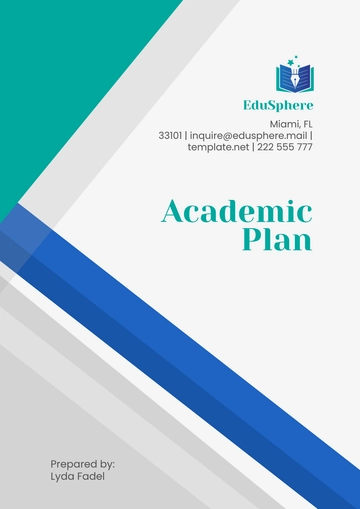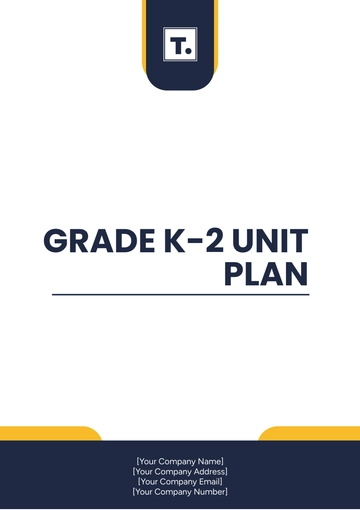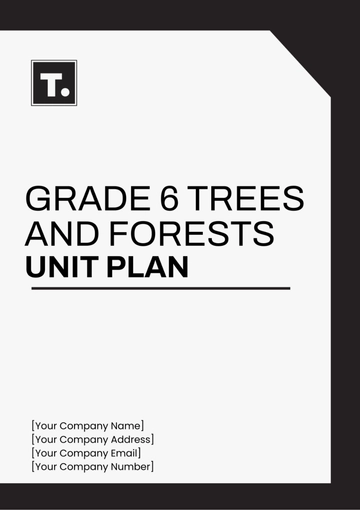Free Individualized Education Plan %28IEP%29

I. Introduction
At [Your Company Name], we are committed to ensuring that every student receives the individualized support they need to thrive in an educational setting. This Individualized Education Plan (IEP) is designed to address the unique learning requirements of students with disabilities, as mandated by the Individuals with Disabilities Education Act (IDEA). Our goal is to provide personalized educational strategies that foster academic achievement, social-emotional development, and the acquisition of essential life skills. The IEP serves as a collaborative framework for educators, parents, specialists, and students to ensure all parties are working toward measurable and realistic goals tailored to the student’s needs.
This document is developed through a team-based approach, taking into account the student’s strengths, challenges, and present levels of performance. [Your Company Name] recognizes the importance of a holistic approach in creating an inclusive learning environment where students can grow academically and personally. This plan not only meets legal requirements but also sets the foundation for positive, long-term educational outcomes. The IEP will be reviewed and adjusted regularly to ensure it remains aligned with the student’s progress and evolving needs, fostering an ongoing partnership between the school, family, and any involved specialists.
II. Student Information
A well-rounded IEP begins with a clear profile of the student, capturing critical information that will guide the development and execution of the plan. Knowing the student's grade level, diagnosis, and primary contact helps the IEP team align their strategies with the student’s specific circumstances. These foundational details ensure that everyone involved is working from a shared understanding, allowing for more focused and effective interventions. By gathering comprehensive student data, [Your Company Name] aims to create a learning environment tailored to each student's needs.
Category | Details |
|---|---|
Student Name | [Student's Name] |
Grade | 6th Grade |
Disability | ADHD |
Primary Contact | [Name] (Mother) |
These key details form the foundation of the IEP, allowing the team to create a personalized plan that addresses the student's unique challenges and strengths. By keeping the student’s background and needs at the forefront, [Your Company Name] ensures that all interventions are purposeful and aligned with long-term educational goals.
III. Present Levels of Performance
[Student's Name] exhibits notable strengths in specific academic areas, particularly mathematics and physical education. In math, he consistently demonstrates a strong grasp of problem-solving skills, logical thinking, and computational accuracy. His ability to stay engaged in hands-on activities and physical education further highlights his strengths in kinesthetic learning environments. These areas of success provide opportunities to build confidence and serve as motivational tools in his broader academic journey. The IEP team can leverage these strengths to create interdisciplinary learning opportunities, incorporating elements of math and physical activity into other subjects, particularly to increase engagement.
However, [Student's Name] faces significant challenges in reading comprehension and maintaining sustained focus, particularly during long or multi-step classroom activities. His ADHD symptoms manifest as difficulty staying attentive, following multi-step instructions, and organizing his thoughts, particularly in reading-intensive tasks. This results in fluctuating academic performance, with notable inconsistencies in his work quality and completion. During reading activities, he struggles to infer meaning, analyze complex texts, and retain information. This has led to gaps in his literacy development, which in turn affects his performance in subjects that require strong reading comprehension skills. To address these challenges, targeted interventions such as breaking tasks into smaller steps, implementing frequent breaks, and providing visual aids or graphic organizers will be incorporated into the plan. These accommodations aim to enhance his focus and comprehension, creating a more supportive and structured learning environment.
IV. Annual Goals
Annual goals are essential components of the IEP, providing clear, measurable objectives that guide [Student's Name]'s progress throughout the school year. These goals are designed to address specific areas where the student needs improvement, ensuring focused interventions and strategies that foster both academic and personal growth. Each goal aligns with the student’s unique challenges and strengths, aiming for progress that is both realistic and attainable. Below is a list of [Student's Name]’s key goals for the upcoming year, which will serve as benchmarks to evaluate his success and adjust strategies as needed:
Improve reading comprehension skills to grade level by the end of the school year.
Increase focus and on-task behavior during classroom activities by 50% within the next two semesters.
Develop self-advocacy skills to request breaks as needed and manage ADHD symptoms better.
V. Special Education Services
Special education services are tailored to meet [Student's Name]’s individual learning and behavioral needs, ensuring access to the necessary support for academic success. These services include specialized instruction, therapies, and accommodations that address his challenges while leveraging his strengths. The goal is to provide a structured environment that enhances learning and personal growth. Below is a list of the key services that will be provided to [Student's Name] throughout the school year to support his progress:
Resource Room: | 3 times a week for reading support. |
Behavioral Therapy: | Weekly sessions with a school psychologist. |
Classroom Accommodations: | Extended time on tests, preferential seating, and regular breaks. |
VI. Evaluation and Reporting
[Student Name]’s progress toward the annual goals will be closely monitored through a combination of regular evaluations and formal assessments. Progress will be reviewed quarterly, allowing the IEP team to analyze performance data and make necessary adjustments to instructional strategies. This ongoing assessment ensures that any areas of concern are identified early, and interventions can be adapted to meet [Student Name]’s evolving needs. In addition to academic performance, the team will assess behavioral progress, focusing on improvements in attention, focus, and self-advocacy skills. The goal is to maintain a proactive and responsive approach to [Student Name]’s development.
Parents and educators will meet twice a year to discuss detailed progress reports and review assessment data, fostering a collaborative environment for decision-making. These meetings are an opportunity to reflect on [Student Name]’s achievements and challenges, ensuring that the IEP remains aligned with his growth. If necessary, adjustments to the goals, accommodations, or services will be made to support continued progress. Additionally, formal evaluations will be conducted annually to re-evaluate the student’s needs and determine whether the current level of special education services remains appropriate. This structured reporting and evaluation process ensures that [Student Name] receives the support necessary for long-term success.
VII. Parental Involvement
Parental involvement plays a pivotal role in [Student Name]’s educational success, providing consistency between the home and school environments. At [Your Company Name], we recognize that active parent engagement fosters stronger academic outcomes, especially for students with individualized needs. Parents will be regularly informed about [Student Name]’s progress through weekly emails from teachers, detailing classroom performance and any notable improvements or challenges. This ongoing communication will ensure that parents remain up-to-date and can address any concerns as they arise.
Monthly meetings between parents and educators will also be scheduled to discuss [Student Name]’s progress in greater detail. These meetings will provide a collaborative space for discussing any adjustments to the IEP, reviewing strategies that have been effective, and planning any additional interventions. Parental input is highly valued in this process, as they provide key insights into how [Student Name] is managing his goals and behaviors outside of the classroom.
Parents are encouraged to take an active role in supporting the IEP at home. This includes monitoring homework, reinforcing classroom strategies, and ensuring [Student Name] stays focused on his IEP goals. By fostering consistent practices at home, parents can help solidify the skills [Student Name] is developing at school. The combined efforts of the school and family will significantly enhance his ability to achieve academic and personal growth.
VIII. Conclusion
The Individualized Education Plan (IEP) for [Student Name] is a dynamic and flexible document crafted to address his specific educational needs and challenges. As a living document, it evolves with [Student Name]’s growth and progress, incorporating regular updates and modifications based on ongoing assessments and feedback. This adaptability is crucial for meeting the unique requirements of [Student Name] and ensuring that the educational strategies remain effective and relevant. The IEP aims to provide a structured yet responsive approach to supporting his academic and behavioral development.
Successful implementation of the IEP hinges on the continuous collaboration among all stakeholders, including educators, parents, and specialists. Regular monitoring and assessment will track [Student Name]’s progress toward his goals, allowing for timely adjustments to interventions and support. Through a commitment to open communication and a shared focus on [Student Name]’s success, the IEP will serve as a comprehensive guide for maximizing his educational potential. By working together, we can create an environment where [Student Name] can thrive academically, socially, and emotionally, ultimately achieving his full potential and setting the stage for future success.
- 100% Customizable, free editor
- Access 1 Million+ Templates, photo’s & graphics
- Download or share as a template
- Click and replace photos, graphics, text, backgrounds
- Resize, crop, AI write & more
- Access advanced editor
Develop tailored learning plans with the Individualized Education Plan (IEP) Template. This fully customizable and editable template ensures you can create detailed, student-specific educational strategies. Editable in our AI Editor Tool, it allows for easy adjustments to meet each student's needs. Start personalizing IEPs today with this template from Template.net.
You may also like
- Finance Plan
- Construction Plan
- Sales Plan
- Development Plan
- Career Plan
- Budget Plan
- HR Plan
- Education Plan
- Transition Plan
- Work Plan
- Training Plan
- Communication Plan
- Operation Plan
- Health And Safety Plan
- Strategy Plan
- Professional Development Plan
- Advertising Plan
- Risk Management Plan
- Restaurant Plan
- School Plan
- Nursing Home Patient Care Plan
- Nursing Care Plan
- Plan Event
- Startup Plan
- Social Media Plan
- Staffing Plan
- Annual Plan
- Content Plan
- Payment Plan
- Implementation Plan
- Hotel Plan
- Workout Plan
- Accounting Plan
- Campaign Plan
- Essay Plan
- 30 60 90 Day Plan
- Research Plan
- Recruitment Plan
- 90 Day Plan
- Quarterly Plan
- Emergency Plan
- 5 Year Plan
- Gym Plan
- Personal Plan
- IT and Software Plan
- Treatment Plan
- Real Estate Plan
- Law Firm Plan
- Healthcare Plan
- Improvement Plan
- Media Plan
- 5 Year Business Plan
- Learning Plan
- Marketing Campaign Plan
- Travel Agency Plan
- Cleaning Services Plan
- Interior Design Plan
- Performance Plan
- PR Plan
- Birth Plan
- Life Plan
- SEO Plan
- Disaster Recovery Plan
- Continuity Plan
- Launch Plan
- Legal Plan
- Behavior Plan
- Performance Improvement Plan
- Salon Plan
- Security Plan
- Security Management Plan
- Employee Development Plan
- Quality Plan
- Service Improvement Plan
- Growth Plan
- Incident Response Plan
- Basketball Plan
- Emergency Action Plan
- Product Launch Plan
- Spa Plan
- Employee Training Plan
- Data Analysis Plan
- Employee Action Plan
- Territory Plan
- Audit Plan
- Classroom Plan
- Activity Plan
- Parenting Plan
- Care Plan
- Project Execution Plan
- Exercise Plan
- Internship Plan
- Software Development Plan
- Continuous Improvement Plan
- Leave Plan
- 90 Day Sales Plan
- Advertising Agency Plan
- Employee Transition Plan
- Smart Action Plan
- Workplace Safety Plan
- Behavior Change Plan
- Contingency Plan
- Continuity of Operations Plan
- Health Plan
- Quality Control Plan
- Self Plan
- Sports Development Plan
- Change Management Plan
- Ecommerce Plan
- Personal Financial Plan
- Process Improvement Plan
- 30-60-90 Day Sales Plan
- Crisis Management Plan
- Engagement Plan
- Execution Plan
- Pandemic Plan
- Quality Assurance Plan
- Service Continuity Plan
- Agile Project Plan
- Fundraising Plan
- Job Transition Plan
- Asset Maintenance Plan
- Maintenance Plan
- Software Test Plan
- Staff Training and Development Plan
- 3 Year Plan
- Brand Activation Plan
- Release Plan
- Resource Plan
- Risk Mitigation Plan
- Teacher Plan
- 30 60 90 Day Plan for New Manager
- Food Safety Plan
- Food Truck Plan
- Hiring Plan
- Quality Management Plan
- Wellness Plan
- Behavior Intervention Plan
- Bonus Plan
- Investment Plan
- Maternity Leave Plan
- Pandemic Response Plan
- Succession Planning
- Coaching Plan
- Configuration Management Plan
- Remote Work Plan
- Self Care Plan
- Teaching Plan
- 100-Day Plan
- HACCP Plan
- Student Plan
- Sustainability Plan
- 30 60 90 Day Plan for Interview
- Access Plan
- Site Specific Safety Plan





























